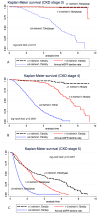Longitudinal change in estimated GFR among CKD patients: A 10-year follow-up study of an integrated kidney disease care program in Taiwan
- PMID: 28380035
- PMCID: PMC5381774
- DOI: 10.1371/journal.pone.0173843
Longitudinal change in estimated GFR among CKD patients: A 10-year follow-up study of an integrated kidney disease care program in Taiwan
Abstract
Background: This study examined the progression of chronic kidney disease (CKD) by using average annual decline in estimated GFR (eGFR) and its risk factors in a 10-year follow-up CKD cohort.
Methods: A prospective, observational cohort study, 4600 individuals fulfilled the definition of CKD, with or without proteinuria, were followed for 10 years. The eGFR was estimated by the MDRD equation. Linear regression was used to estimate participants' annual decline rate in eGFR. We defined subjects with annual eGFR decline rate <1 ml/min/1.73 m2 as non-progression and the decline rate over 3 ml/min/1.73 m2 as rapid progression.
Results: During the follow-up period, 2870 (62.4%) individuals had annual eGFR decline rate greater than 1 ml/min/1.73 m2. The eGFR decline rate was slower in individuals with CKD diagnosed over the age of 60 years than those with onset at a younger age. Comparing to subjects with decline rate <1 ml/min/1.73 m2/year, the odds ratio (OR) of developing rapid CKD progression for diabetes, proteinuria and late onset of CKD was 1.72 (95% CI: 1.48-2.00), 1.89(1.63-2.20) and 0.68 (0.56-0.81), respectively. When the model was adjusted for the latest CKD stage, comparing to those with CKD stage 1, patients with stage 4 and stage 5 have significantly higher risks for rapid progression (OR, 5.17 (2.60-10.25), 19.83 (10.05-39.10), respectively). However, such risk was not observed among patients with the latest CKD stage 2 and 3. The risk for incident ESRD was 17% higher for each 1 ml/min/1.73 m2 increasing in annual decline rate.
Conclusions: Not everyone with CKD develops ESRD after a 10-year follow-up. Absolute annual eGFR decline rate can help clinicians to better predict the progression of CKD. Individuals with renal function decline rate over 3 ml/min/1.73 m2/year require intensive CKD care.
Conflict of interest statement
Figures
References
-
- Saran R, Li Y, Robinson B, Abbott KC, Agodoa LY, Ayanian J, et al. US Renal Data System 2015 Annual Data Report: Epidemiology of Kidney Disease in the United States. American journal of kidney diseases: the official journal of the National Kidney Foundation. 2016;67(3 Suppl 1):Svii, S1–305. Epub 2016/03/02. - PMC - PubMed
-
- System USRD. 2015 USRDS annual data report: Epidemiology of Kidney Disease in the United States. Bethesda, MD: National Institutes of Health, National Institute of Diabetes and Digestive and Kidney Diseases; 2015.
-
- KDIGO_CKD_Work_Group. KDIGO 2012 clinical practice guideline for the evaluation and management of chronic kidney disease. Kidney Int Suppl. 2013;3:1–150. - PubMed
Publication types
MeSH terms
LinkOut - more resources
Full Text Sources
Other Literature Sources
Medical
Research Materials
Miscellaneous



